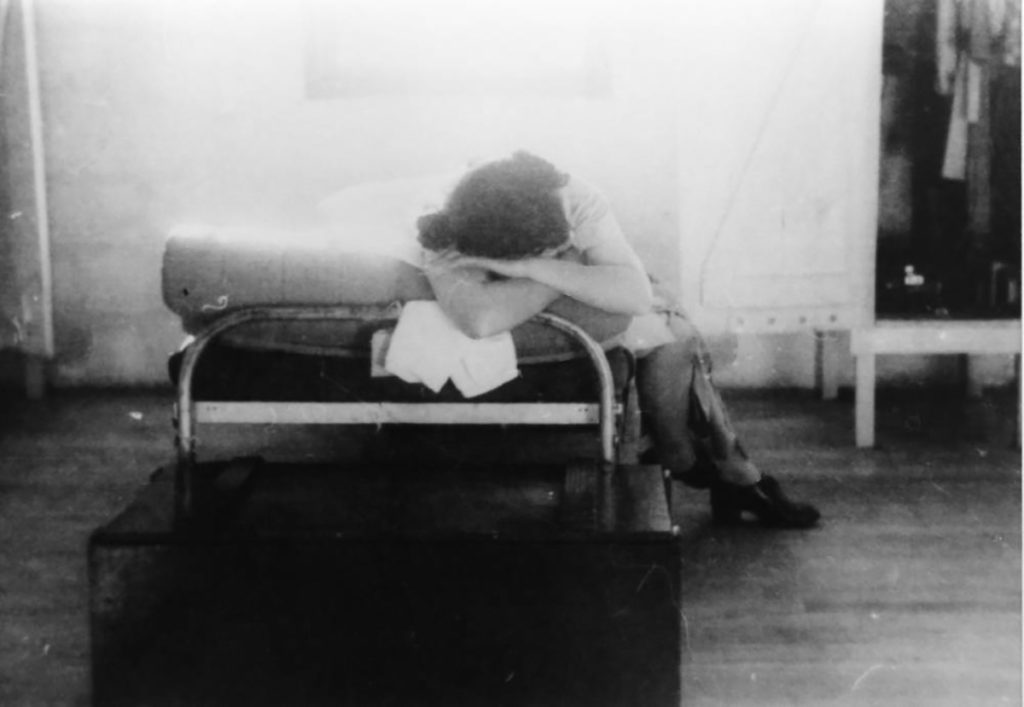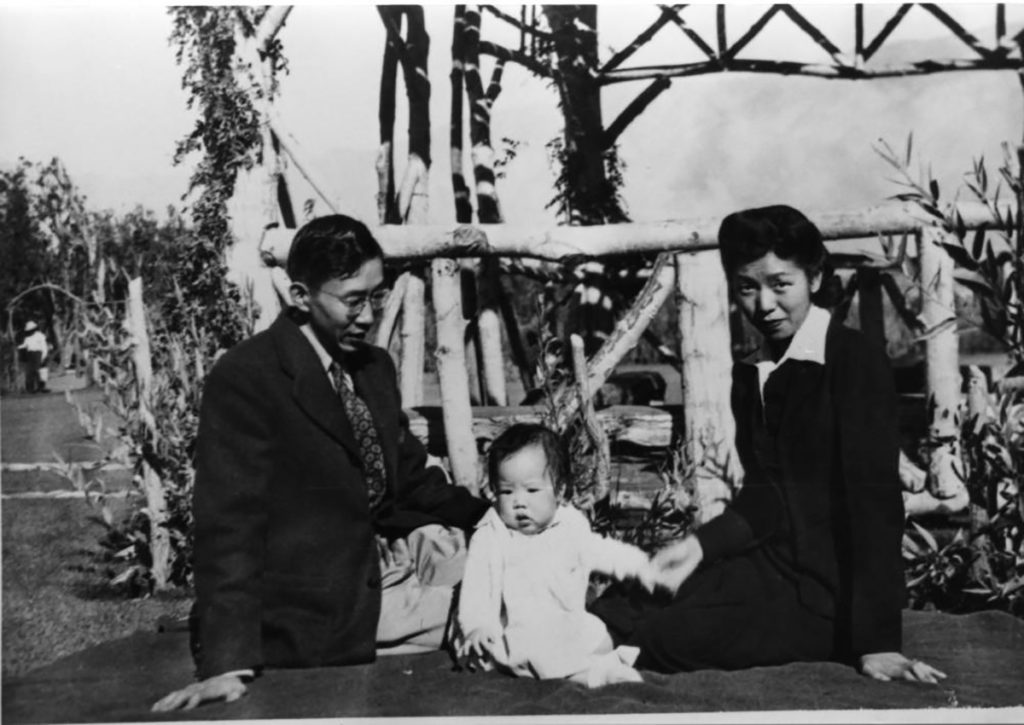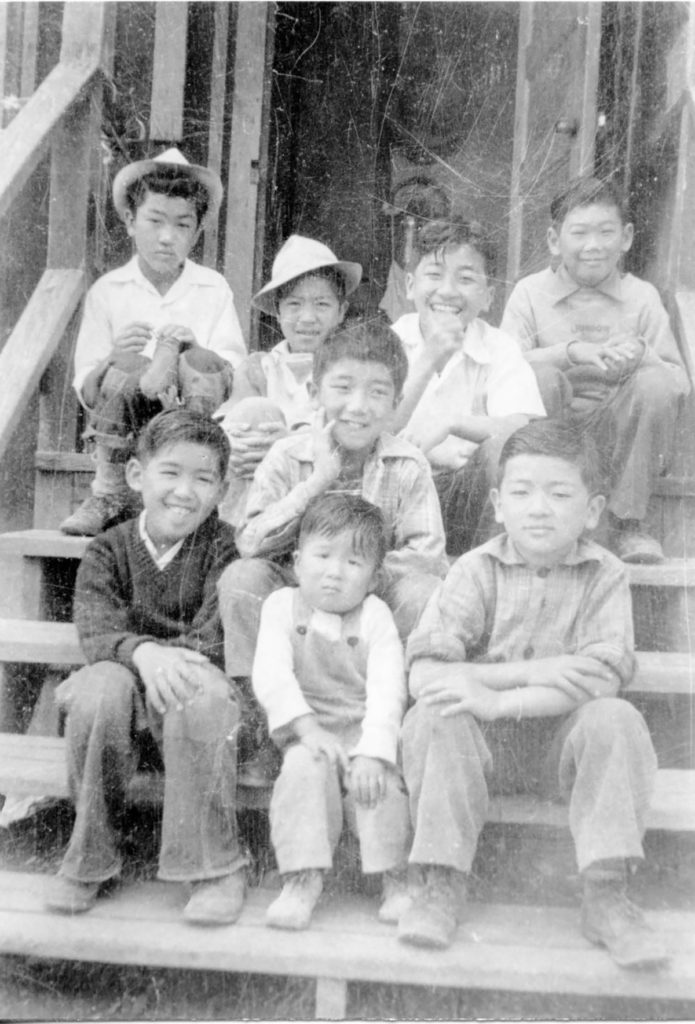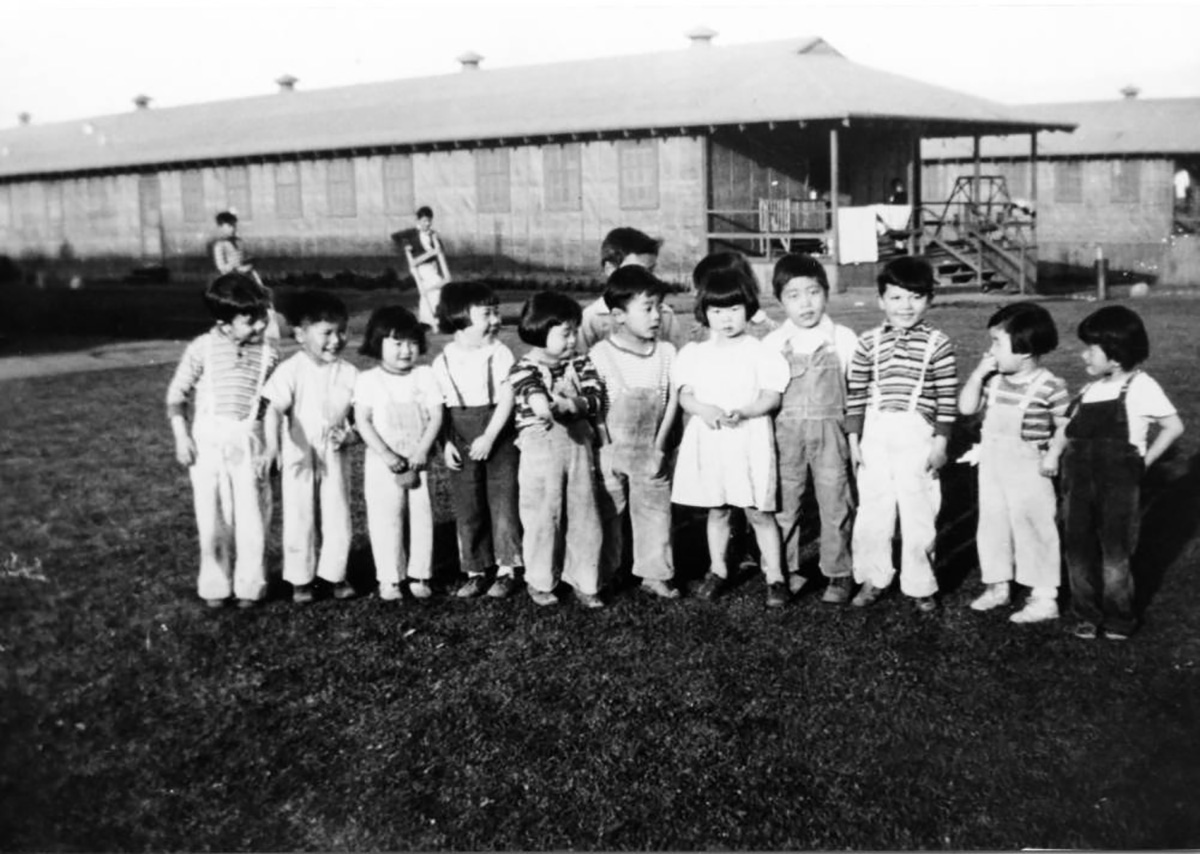November 29, 2021
Kenji Suematsu was living with his parents and siblings in Costa Mesa, California at the outbreak of World War II. His father, an immigrant farmer from Japan, was apprehended by the FBI shortly after the bombing of Pearl Harbor. His mother, suddenly alone with her three children and an uncertain future, suffered a nervous breakdown.
In a panic to get out of Costa Mesa, Kenji’s mother instructed him to drive the family car. He was six years old at the time, and had no idea what he was doing. Decades later, he recalled in an interview with Densho:
“She had me sit behind the steering wheel of the car…and gave me the car keys and [said], ‘Get the car started so we can get going.’”[i]
As the car began to roll out of control, a neighbor intervened and called for help. The mother was determined unfit to care for her children and sent to a sanatorium in San Bernardino, while her children—suddenly orphaned by circumstance—were sent to a home for Japanese American children in Los Angeles.
Stories like Kenji’s show that family separation during Japanese American WWII incarceration didn’t follow the script we’ve seen at other times in history. There were no auction blocks, no boarding schools, no deliberate separation and shuffling between detention sites at the border. Nevertheless, many Japanese American children still faced family separation as the US hastened to contain an imagined enemy hiding out along its Western coast.
Many cases of family separation involved children being separated from fathers who had been swept up in the raids that targeted community leaders, language teachers, and others whose activities had landed them on an FBI watchlist. But in some cases, children lost or were separated from both parents. For them, the US Government made special accommodations in the Manzanar Children’s Village, an orphanage inside one of the ten US War Relocation Authority (WRA) concentration camps.
The Shonien
Like many wartime orphans, Kenji Suematsu’s experience of separation was not an isolated incident, but rather a painful pattern repeated in different iterations over the course of his childhood. Upon arrival at the Shonien—a Los Angeles orphanage run by and for Japanese Americans—he was separated from his siblings because they fell into different age groups. Though he wasn’t able to see his own family, he began to form bonds with the other children.
But the Shonien itself was undergoing major upheaval. The home’s founder and director, Rokuichi “Joy” Kusumoto was, like Kenji’s father, arrested in the initial FBI sweeps following Pearl Harbor. He was sent first to an internment camp in Missoula, Montana and later deported to Japan where he died in obscurity.[ii]
After President Roosevelt signed Executive Order 9066 on February 19, 1942, it was initially unclear whether the staff of the Japanese American orphanages would be incarcerated along with over 100,000 of their West Coast brethren. Harry and Lillian Matsumoto, a married couple that had taken over the Shonien after Kusumoto’s arrest, advocated for keeping the children with their caretakers in Los Angeles in order to maintain some semblance of normalcy and structure.[iii]
Despite pleas to allow the children to remain with their known caretakers in the Shonien for the duration of the war, the residents of the home were issued their own exclusion order by Col. Karl R. Bendetsen on April 28, 1942.[iv] Heeding the calls to keep the children together, the WRA established a prison specifically for orphaned children, known euphemistically as the “Children’s Village” within the confines of California’s Manzanar concentration camp.
“A Very Lonely Place and Sad Too”
So in June 1942, Kenji and just over one hundred other children who posed some phantom threat to national security were relocated to Manzanar. Some were as young as six months old; many had living parents or relatives who were being detained elsewhere.
Because the government was liberal in its definition of who counted as Japanese American, some of the mixed race detainees had had little to no association with the community they were now imprisoned with. Dennis Bambauer, for example, a blond haired, blue eyed boy residing in another Los Angeles-area orphanage did not even know he was Japanese American until someone checked his file and turned him in.[v] There was also the case of two half Japanese girls whose white grandmother voluntarily surrendered them to authorities.[vi]

Also included in this unfortunate lot were the children of Minnie Shirai, an Alaska Native woman married to a man of mixed Indigenous and Japanese ancestry.[vii] While she was hospitalized in a tuberculosis sanatorium, her husband was incarcerated at Minidoka and their “orphaned” children sent alone to Manzanar. During their separation, Minnie was unable to communicate with her children or get adequate updates on their wellbeing from orphanage administrators.
In a letter to the WRA she wrote, “What’s this all about? I never hear from my children for quite a while now! Will you please let me know why? I am very much worried about my children.” And later followed with, “I’m going to be kicked out for crying to[o] much. How can any person get well when they are worried [and] lonesome.”[viii]
The population of the Children’s Village would continue to grow as the war continued: more children arriving from West Coast orphanages, babies born to young mothers out of wedlock, and others orphaned by the death of their parents during their incarceration.
Although the Children’s Village was housed within the larger concentration camp, the orphans were not permitted to interact with the general population except at school. Kenji recalled being told that they would get shot if they moved too close to the fence.
Francis Honda was seven when he arrived there. Years later, in 1981, he testified for the Commission on Wartime Relocation and Internment of Civilians hearings, and recalled: “It was a very lonely place and sad too, with babies crying and nothing to do. It was like the end of the world for me.”[ix]
Despite being kept separate, there were clear overlaps in the underlying agendas of the orphanage and the broader concentration camp system.
Once Manzanar was up and running, the WRA made swift work of educating the orphans to be model citizens, just as they worked to transform all detainees into “loyal” Americans.
As the Manzanar Free Press reported, “Each child was instructed in the fundamental duties of housekeeping according to age and to strength while the value of money and its uses were taught by means of providing each child with spending money, and a savings account.”[x]
Harry Matsumoto was himself a Christian and, in keeping with other social reformers of his day, believed that a good “Christian upbringing” was the best way to set indigent children up for success. “We realize that our children must be taught to become good citizens of the country of their birth and to believe in the Christian way of life.”[xi]

Matsumoto’s views were informed by his religious beliefs but also reflected a vein of assimilationist thinking adopted by some Japanese Americans during WWII. While this might now be understood as survivalism, attempts to emulate “loyal” (read white) American values were highly controversial during WWII and have resulted in lingering divisions in the Japanese American community.
This assimilationist thinking was not unique to Japanese American history, of course. Native American boarding schools were also infamous sites of acculturation. The boarding school system is unparalleled in its longevity and in the systematic violence used to mold Indigenous youth into an ideal American citizenry, but it’s still important to note that this kind of indoctrination is a current that runs through much of our country’s history.
Kinship Ties Forged and Broken
Back at Manzanar, Kenji and his siblings eventually learned that his father was imprisoned in the same concentration camp as them. Although the family was not immediately allowed to live together again, they were permitted to visit one another. His mother, who had been exposed to shock therapy during her stay at the sanatorium, eventually joined the family as well.
But Kenji says the family was broken due to the long separation during a critical period of the children’s development. When they could finally live together again, he says they didn’t even feel like a family any more. “We were just five bodies in a room,” he said.[xii]

Meanwhile, those who remained at the Children’s Village formed new kinds of kinship amongst themselves. Several survivors recalled John Sohei Hohri as being a particularly strong pillar of that Children’s Village family. Hohri was himself an orphan, first at the Shonien and later at the Children’s Village until he turned 18 and was “released” to the larger concentration camp. He returned to the orphanage for the duration of his time at Manzanar as a staff member, but also so much more. Many identified him as an older brother figure who captivated the children through nightly story time sessions in which he would recount from memory captivating versions of Homer’s Odyssey and Les Miserables.[xiii]
As the WRA moved to shutter Manzanar in 1945, the orphaned children who remained were once again subjected to separation, this time from the strong kinship networks they had formed with staff and fellow orphans. Many reported that this move was even more painful than the others because they were losing the only family they had ever known.
Since the Japanese orphanages would not be reopening, the residents were left to seek other placement options. In some cases this meant reunification with parents; while for some it meant going wherever they could find jobs as in-home domestic workers. Others still were adopted or placed in non-Japanese foster homes.[xiv]
Wilma Stuart, a white woman who lived in Los Angeles, hosted two girls after they were released from the Children’s Village. In an oral history conducted in 1993, it was clear that she cared for the girls but was oblivious to the lingering trauma or ongoing discrimination they were surely grappling with.[xv]
“I don’t know about Manzanar,” she told an interviewer. “They were passing out the children to homes when the war was over. I asked them if they had any they could send me, so they sent me over the two, Annie and Celeste. Celeste stayed with me for a long time. Annie stayed the longest.”
Despite the breakup of the family systems that had formed within the Children’s Village, many of the former residents remained connected to each other for the rest of their lives. In a talk at the 1992 Manzanar Children’s Village Reunion in Los Angeles, Sohei Hohri recalled the strong sense of camaraderie that still existed among the former residents of the orphanage: “Three years ago Shioo Matsuno said it best with these words to Aki Isozaki and me: ‘You are my brothers.’ The passing years have proven it, and our hearts say it is so: Sisters and brothers.”[xvi]
But Hohri, who had gone on to become an artist, librarian, and avid book collector, also noted that, “in all of America’s shameful, illegal internment of Japanese and Japanese Americans, the most shameful episode remains the internment of orphanage children. Taken not only from orphanages, but even from foster homes.”
Indeed, the Children’s Village and the decisions about who should be detained within its walls, made an even greater farce out of the idea that an entire race of people, many of them born on American soil, were harboring some allegiance to a foreign power. While the entire incarceration was premised upon unfounded racist paranoia, the act of incarcerating children—some of whom had only nominal ties to Japanese American identity—casts an even brighter light on the hypocrisy that undergirded the decision to imprison an entire population based on their race and ancestral origins.
Seeing the treatment of Japanese American orphans within this larger trajectory of family separation underscores a particular pattern of US settler colonialism: one in which kinship networks were disrupted and replaced with paternalistic attempts to mold a compliant citizenry.
Family Separation Today
Japanese American activists fought for and won reparations for this injustice in the 1980s. A presidential apology and payouts of $20,000 to living survivors of WWII incarceration is far from an adequate amends considering the the human and financial tolls of the incarceration, and yet it’s still noteworthy considering that African Americans and Native Americans have yet to receive any kind of similar reparations for the centuries of atrocities they have endured. This disparity is partly what motivates ongoing social justice action among Japanese American survivors and descendents today.
The grassroots coalition Tsuru for Solidarity formed in response to the Trump administration’s blatantly inhumane policy of separating immigrant families in an attempt to quell border crossing. Tsuru for Solidarity’s first action took place at the biannual Tule Lake pilgrimage, which in 2018 happened to coincide with nationwide Families Belong Together actions organized by Congresswoman Pramila Jayapal.
One octogenarian who himself had been incarcerated as a child said he had never identified as an activist and was initially reluctant to join the protest, but during the action, was out there with dozens of others pumping his fist in the air and yelling “Kodomo no tame ni (for the sake of the children) / they’re our children, set them free.”
Survivors, descendants, and allies also planned a protest at the largest prison for immigrant families, the Dilley detention facility outside of San Antonio, Texas, just miles from where Japanese American and Japanese Latin American families had been detained at the Crystal City internment camp. The group has since orgranized to protest the detention of undocumented immigrants at sites all over the country.
Some of these actions have taken place at sites of multilayered violence. Fort Sill in Oklahoma, for example, was proposed as a prison for undocumented children separated from their parents at the border. Previously, the facility had been used as a prison for Japanese Americans during WWII, and as a Native American boarding school, and as a Prisoner of War camp for members of the Chiricahua Apache including Geronimo, who is now laid to rest there.[xvii]
When members of Tsuru for Solidarity gathered to protest at Fort Sill in 2018 a guard tried to force them to move. In Democracy Now footage of the event, Satsuki Ina, a WWII incarceration survivor and one of the founders of Tsuru for Solidarity, can be seen holding her ground and stating firmly, “We’ve been removed too many times.”[xviii]
In considering the histories and ongoing traumas of family separation and child incarceration, Satsuki’s act of refusal and the larger solidarity movement she’s part of, remind us that another world is possible. Family separation is part of our past, it’s part of our present, but we can collectively work to make sure it’s no one’s future.
—
By Natasha Varner, Densho Communications and Public Engagement Director
This post has been cross-published with Tropics of Meta: Historiography for the Masses.
[Header: Thirteen incarcerees at the Manzanar Children’s Village. Original photograph inscription: “Left to right: Sunny, Haracy (?), Tatsue, Shizuko, Kazuye, Susumi, Yetsuko (Yetsudo?), Tadashi, Dickie, Hideko, Kindo (?). Courtesy of the Lawrence de Graaf Center For Oral and Public History, California State University, Fullerton.]
Bibliography
Hohri, John Sohei. Manzanar Children’s Village Reunion Talk, May 24 1992, (accessed online Sept 21 2021) http://soheihohri.blogspot.com/
Irwin, Catherine. “Manzanar Children’s Village,” Densho Encyclopedia https://encyclopedia.densho.org/Manzanar%20Children’s%20Village (accessed Oct 12 2021).
“Japanese-American Internment Survivors Protest Plan to Jail Migrant Kids At Fort Sill,” a WWII Camp” Democracy Now, June 24, 2019 (accessed online Oct 18 2021) https://www.youtube.com/watch?v=S7l1jga_R3o
Maruyama, Hana, “What Remains: Japanese American World War II Incarceration in Relation to American Indian Dispossession.” Doctoral dissertation, University of Minnesota, 2021.
Nobe, Lisa. “The Children’s Village at Manzanar: The World War II Eviction and Detention of Japanese American Orphans.” Journal of the West 38, no. 2 (1999): 65-71.
Stuart, Wilma. “Interview with Wilma Stuart.” By Noemi Romero and Celia Cardenas. Children’s Village at Manzanar Oral History Project, July 11, 1993 (accessed online Oct 12 2021) https://ddr.densho.org/ddr-csujad-30-5/
Suematsu, Kenji. “Interview with Kenji Suematsu.” By Sharon Yamato. Densho Visual History Collection, April 19, 2012 (accessed online Sept 21 2021) https://ddr.densho.org/narrators/657/
Tawa, Renee. “Childhood Lost: the Orphans of Manzanar.” The Los Angeles Times, Los Angeles, CA, March 11, 1997 (accessed online Sept 21 2021) https://www.latimes.com/archives/la-xpm-1997-03-11-mn-37002-story.html
Wallace, Nina and Natasha Varner, “Fort Sill is a Site of Ongoing Trauma,” Densho Blog, June 12, 2019 (accessed online Oct 12 2021) https://www.densho.org/fort-sill-is-a-site-of-ongoing-trauma/
[i] Suematsu, “Interview.”
[ii] Catherine Irwin. “Manzanar Children’s Village,” Densho Encyclopedia https://encyclopedia.densho.org/Manzanar%20Children’s%20Village (accessed Oct 12 2021).
[iii] Lisa Nobe, “The Children’s Village at Manzanar: The World War II Eviction and Detention of Japanese American Orphans,” Journal of the West 38, no. 2, 66.
[iv] Renee Tawa. “Childhood Lost: the Orphans of Manzanar,” The Los Angeles Times, Los Angeles, CA, March 11, 1997 (accessed online Sept 21 2021) https://www.latimes.com/archives/la-xpm-1997-03-11-mn-37002-story.html
[v] Nobe, 69.
[vi] Tawa, Ibid.
[vii] Hana Maruyama, “What Remains: Japanese American World War II Incarceration in Relation to American Indian Dispossession,” (doctoral dissertation, University of Minnesota, 2021), 292.
[viii] Maruyama, 297-298.
[ix] Tawa, Ibid.
[x] “Children’s Village Slated to Close End of August,” Manzanar Free Press, 7, No. 13, August 18, 1945, (accessed online Sept 21 2021) https://ddr.densho.org/ddr-densho-125-364/
[xi] Nobe, 68.
[xii] Suematsu, Ibid.
[xiii] Nobe, 70.
[xiv] Nobe, Ibid.
[xv] Stuart, “Interview.”
[xvi] John Sohei Hohri, Manzanar Children’s Village Reunion Talk, May 24 1992, (accessed online Sept 21 2021) http://soheihohri.blogspot.com/
[xvii] Nina Wallace and Natasha Varner, “Fort Sill is a Site of Ongoing Trauma,” Densho Blog, June 12, 2019, https://www.densho.org/fort-sill-is-a-site-of-ongoing-trauma/
[xviii] “Japanese-American Internment Survivors Protest Plan to Jail Migrant Kids At Fort Sill, a WWII Camp” Democracy Now, June 24, 2019, https://www.youtube.com/watch?v=S7l1jga_R3o, accessed Oct. 18 2021.
